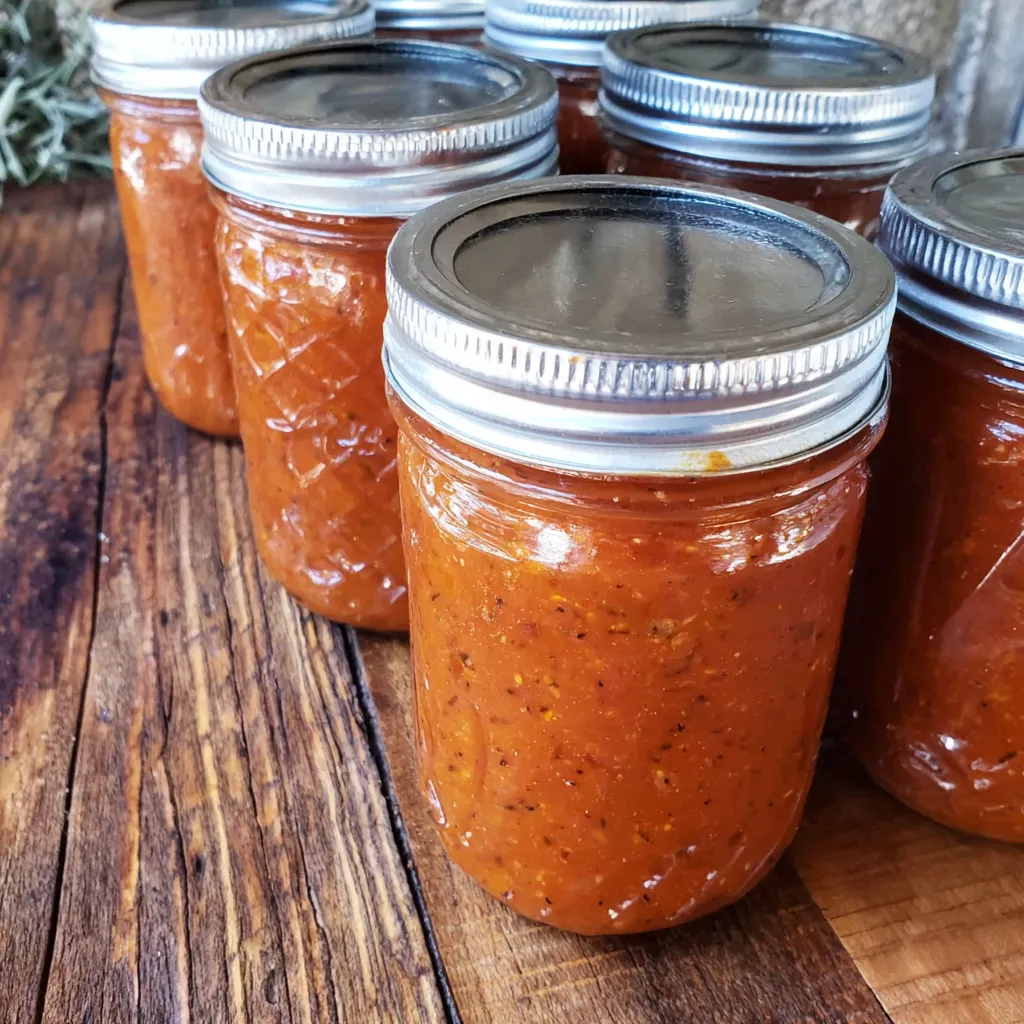Imagine the taste of summer, bursting with the sweet and tangy flavor of ripe tomatoes, captured in a jar to brighten even the coldest winter day. That’s precisely what you’ll achieve with this recipe for the best homemade roasted tomato spaghetti sauce canning. We’re talking serious flavor here, friend, and I’m going to walk you through every single step to ensure your pantry is stocked with liquid gold. Get ready to ditch the store-bought stuff forever!
Gathering Your Garden’s Bounty

Before we dive into the roasting and simmering magic, let’s make sure you have all the ingredients ready. Fresh, high-quality ingredients are key to an unforgettable sauce.
The Tomato Core:
- About 20 pounds of ripe Roma tomatoes (or other paste tomatoes): These are the workhorses of our sauce, providing that rich tomato flavor.
Aromatic All-Stars:
- 2 large yellow onions: Diced, they’ll caramelize beautifully during roasting.
- 8-10 cloves of garlic: Minced or roughly chopped, depending on your preference.
- 1/2 cup of fresh basil leaves: Roughly chopped; fresh herbs make a huge difference!
- 1/4 cup of fresh oregano leaves: Roughly chopped, adding a touch of earthy sweetness.
Flavor Boosters:
- 1/4 cup extra virgin olive oil: For roasting those veggies to perfection.
- 2 tablespoons balsamic vinegar: Adds a touch of acidity and depth.
- 2 teaspoons granulated sugar: Helps balance the acidity of the tomatoes.
- 2 tablespoons kosher salt: To taste; helps draw out moisture and enhance flavor.
- 1 teaspoon freshly ground black pepper: For a little kick.
- 1/2 teaspoon red pepper flakes (optional): For a touch of heat.
For Safe Canning:
- 1/4 cup bottled lemon juice: This is crucial for ensuring the acidity is high enough for safe canning, especially with tomatoes, which can vary in acidity.
Step-by-Step to Spaghetti Sauce Perfection
Alright, let’s get cooking! Don’t be intimidated by the process; I’m here to guide you every step of the way. We’re going to roast, simmer, and can our way to homemade sauce heaven.
Roasting the Vegetables:
- Preheat your oven to 400°F (200°C).
- Wash and core your tomatoes. You can leave the skins on – we’ll take care of those later! Cut them in half or quarters, depending on their size.
- In a large bowl, toss the tomatoes, diced onions, and garlic with the olive oil, balsamic vinegar, sugar, salt, pepper, and red pepper flakes (if using). Make sure everything is nicely coated.
- Spread the mixture in a single layer on two large baking sheets. Don’t overcrowd the pans, or the vegetables will steam instead of roast.
- Roast for 45-60 minutes, or until the tomatoes are soft and slightly caramelized, and the onions are tender. Stir halfway through for even roasting.
Simmering the Sauce:
- Once the vegetables are roasted, transfer them to a large pot or Dutch oven.
- Bring the mixture to a simmer over medium heat.
- Use an immersion blender to blend the sauce until smooth. Alternatively, you can carefully transfer the mixture to a regular blender in batches, being mindful of the hot liquid.
- Stir in the chopped fresh basil and oregano.
- Simmer the sauce, uncovered, for another 30-60 minutes, or until it has thickened to your desired consistency. Stir occasionally to prevent sticking.
- Taste and adjust seasonings as needed. Add more salt, pepper, or sugar to taste.
Canning for Future Feasts
Now for the crucial part: safely preserving our beautiful sauce! Canning might seem a little daunting, but I promise it’s easier than you think. Just follow these steps carefully.
Preparing Your Canning Equipment:
- Gather your canning supplies: You’ll need a large stockpot with a rack, canning jars with lids and bands (make sure the lids are new!), a jar lifter, a wide-mouth funnel, and a ladle.
- Sanitize your jars and lids: Wash the jars and lids in hot, soapy water. Rinse well. Then, sterilize the jars by placing them in a boiling water bath for 10 minutes. Keep the jars hot until you’re ready to fill them. You can sanitize the lids by simmering them in hot water for 10 minutes.
Filling the Jars:
- Add the bottled lemon juice to the sauce. Stir well. This is a crucial step for safety!
- Using the wide-mouth funnel, ladle the hot sauce into the hot jars, leaving 1/2 inch of headspace (the space between the sauce and the top of the jar).
- Remove any air bubbles by gently tapping the jar on the counter or using a non-metallic utensil.
- Wipe the rims of the jars clean with a damp cloth.
- Place the lids on the jars and screw on the bands fingertip-tight (not too tight!).
Processing the Jars:
- Place the jars on the rack in the boiling water bath canner. Make sure the jars are covered by at least 1 inch of water.
- Bring the water to a rolling boil and process the jars for the recommended time, which depends on your altitude and jar size. For pints, process for 35 minutes. For quarts, process for 40 minutes. If you live at a higher altitude, you’ll need to increase the processing time (check a reliable canning resource for specific recommendations).
- Once the processing time is complete, turn off the heat and let the jars sit in the hot water for 5 minutes before carefully removing them with the jar lifter.
- Place the jars on a towel-lined surface and let them cool completely, undisturbed, for 12-24 hours.
Checking for a Good Seal:
- After the jars have cooled, check the seals by pressing down on the center of the lid. If the lid doesn’t flex or pop, it’s properly sealed.
- If any jars didn’t seal, you can either reprocess them with new lids within 24 hours or store them in the refrigerator and use them within a week.
- Label the sealed jars with the date and contents and store them in a cool, dark place for up to a year.
Tips and Tricks for Sauce Success
Let’s talk about some extra tips and tricks to really elevate your Best homemade roasted tomato spaghetti sauce canning game!
Tomato Talk:
- Tomato Variety is Key: Roma or other paste tomatoes like San Marzano have less water and more flesh, resulting in a thicker, richer sauce.
- Ripeness Matters: The riper the tomatoes, the sweeter and more flavorful your sauce will be. Look for tomatoes that are deep red and slightly soft to the touch.
- Skip the Peeling (Mostly): Roasting the tomatoes softens the skins, and the immersion blender takes care of the rest. No need for tedious peeling! However, if you *really* hate tomato skins, you can pass the sauce through a food mill after blending to remove them.
Flavor Finesse:
- Don’t Skimp on the Herbs: Fresh herbs are a game-changer. If you don’t have fresh, you can use dried, but use about 1/3 of the amount.
- Caramelized Onions = Flavor Bomb: The roasting process caramelizes the onions, adding a deep, sweet flavor to the sauce. Don’t rush this step!
- Balsamic Balance: The balsamic vinegar adds a touch of acidity and complexity that elevates the flavor.
- Spice it Up (or Not): The red pepper flakes are optional, but they add a nice little kick. Adjust the amount to your liking. You can also add other spices like Italian seasoning or smoked paprika.
- Sugar Savvy: The sugar helps balance the acidity of the tomatoes. Start with the amount in the recipe and adjust to taste, depending on the sweetness of your tomatoes.
Canning Confidence:
- Safety First!: Canning is a safe and reliable way to preserve food, but it’s important to follow the instructions carefully. Always use proper canning techniques and equipment.
- Altitude Adjustment: If you live at a higher altitude, you’ll need to increase the processing time to ensure proper sealing. Check a reliable canning resource for specific recommendations.
- Headspace is Key: Leaving the correct amount of headspace is crucial for creating a proper vacuum seal.
- Fingertip Tight: Don’t overtighten the bands. They need to allow air to escape during processing.
Serving Suggestions and Sauce Variations
Now that you have jars of delicious homemade roasted tomato spaghetti sauce, let’s talk about how to use it!
- Classic Spaghetti: Of course! Toss it with your favorite cooked pasta for a simple and satisfying meal.
- Pizza Sauce: Spread it on your homemade pizza crust for a taste of Italy.
- Lasagna: Use it as the base for your lasagna.
- CHICKEN SPAGHETTI: Elevate this classic comfort food with the robust flavors of your homemade roasted tomato sauce. CHICKEN SPAGHETTI
- STUFFED PEPPERS: Give your stuffed peppers a flavorful boost by incorporating this rich tomato sauce into the filling. STUFFED PEPPERS
- CREAMY SAUSAGE PARMESAN DREAM: Add a layer of depth to this indulgent dish by using your roasted tomato sauce as a base for the creamy sauce. CREAMY SAUSAGE PARMESAN DREAM
- Sauce Variations:
- Spicy Arrabbiata: Add more red pepper flakes for a spicy kick.
- Vodka Sauce: Stir in a splash of vodka and a dollop of cream for a creamy and decadent sauce.
- Meat Sauce: Brown some ground beef or Italian sausage and add it to the sauce for a heartier meal. Consider checking out SLOW COOKER RAGU for inspiration.
- Creamy Tomato Sauce: Looking for a creamy delight? Try incorporating the techniques used in CREAMY GARLIC PARMESAN CHICKEN PASTA or even CREAMY CHICKEN PASTA with your roasted tomato base.
There you have it! Your very own homemade roasted tomato spaghetti sauce canning recipe. I know you’re going to absolutely love this, and I can’t wait to hear all about your saucy adventures. Happy canning, friend!
Why is lemon juice added to the tomato sauce when canning?
Bottled lemon juice is added to the sauce to ensure the acidity is high enough for safe canning. Tomatoes can vary in acidity, so adding lemon juice guarantees a safe and preserved product.
What type of tomatoes are best to use for this sauce?
Roma tomatoes, or other paste tomatoes like San Marzano, are recommended because they have less water and more flesh, resulting in a thicker, richer sauce.
How long should I process the jars of sauce in a boiling water bath?
For pints, process the jars for 35 minutes. For quarts, process for 40 minutes. If you live at a higher altitude, you’ll need to increase the processing time.
Can I use dried herbs instead of fresh?
Yes, you can use dried herbs, but use about 1/3 of the amount specified for fresh herbs.

Roasted Tomato Canning Sauce
Ingredients
Equipment
Method
- Preheat your oven to 400°F (200°C).
- Wash and core your tomatoes. Cut them in half or quarters, depending on their size.
- In a large bowl, toss the tomatoes, diced onions, and garlic with the olive oil, balsamic vinegar, sugar, salt, pepper, and red pepper flakes (if using). Make sure everything is nicely coated.
- Spread the mixture in a single layer on two large baking sheets. Don’t overcrowd the pans, or the vegetables will steam instead of roast.
- Roast for 45-60 minutes, or until the tomatoes are soft and slightly caramelized, and the onions are tender. Stir halfway through for even roasting.
- Once the vegetables are roasted, transfer them to a large pot or Dutch oven.
- Bring the mixture to a simmer over medium heat.
- Use an immersion blender to blend the sauce until smooth. Alternatively, you can carefully transfer the mixture to a regular blender in batches, being mindful of the hot liquid.
- Stir in the chopped fresh basil and oregano.
- Simmer the sauce, uncovered, for another 30-60 minutes, or until it has thickened to your desired consistency. Stir occasionally to prevent sticking.
- Taste and adjust seasonings as needed. Add more salt, pepper, or sugar to taste.
- Gather your canning supplies: a large stockpot with a rack, canning jars with lids and bands (make sure the lids are new!), a jar lifter, a wide-mouth funnel, and a ladle.
- Wash the jars and lids in hot, soapy water. Rinse well.
- Sterilize the jars by placing them in a boiling water bath for 10 minutes. Keep the jars hot until you’re ready to fill them.
- Sanitize the lids by simmering them in hot water for 10 minutes.
- Add the bottled lemon juice to the sauce. Stir well.
- Using the wide-mouth funnel, ladle the hot sauce into the hot jars, leaving 1/2 inch of headspace.
- Remove any air bubbles by gently tapping the jar on the counter or using a non-metallic utensil.
- Wipe the rims of the jars clean with a damp cloth.
- Place the lids on the jars and screw on the bands fingertip-tight (not too tight!).
- Place the jars on the rack in the boiling water bath canner. Make sure the jars are covered by at least 1 inch of water.
- Bring the water to a rolling boil and process the jars for the recommended time, which depends on your altitude and jar size. For pints, process for 35 minutes. For quarts, process for 40 minutes. If you live at a higher altitude, you’ll need to increase the processing time (check a reliable canning resource for specific recommendations).
- Once the processing time is complete, turn off the heat and let the jars sit in the hot water for 5 minutes before carefully removing them with the jar lifter.
- Place the jars on a towel-lined surface and let them cool completely, undisturbed, for 12-24 hours.
- After the jars have cooled, check the seals by pressing down on the center of the lid. If the lid doesn’t flex or pop, it’s properly sealed.
- If any jars didn’t seal, you can either reprocess them with new lids within 24 hours or store them in the refrigerator and use them within a week.
- Label the sealed jars with the date and contents and store them in a cool, dark place for up to a year.




